Hartney
and the R.M.
of Cameron
1650
1900: The Canadian Northern Railway line from Morris reaches Hartney
1902: Construction of A.E. Hill Co. Store and Lewis Building
1905: Hartney incorporated as a town - The first Mayor is Dr. F.
Woodhull.
1906: Town Hall Constructed
Hartney in 1900 – 1909
1900
Railway line from Elgin, reaches Hartney – eventually linking to
Grande Clairiere and Virden. The first agent is Mr. Donald
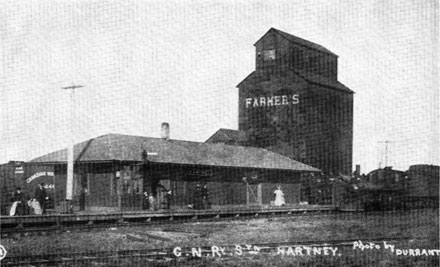
The town deals with the question of a site for fair.
The establishment of a Creamery is discussed.
Alex Mains, with his brother, starts a planing mill, which soon became
a sash and door factory, and eventually (1904) The Hartney
Manufacturing Company.
ca 1900 – 3 more elevators are built.
In December the Hartney District Businessman’s Association is
formed to enhance urban needs versus farmer’s needs.
A Stage coach between Hartney and Meglund runs two days a week; and
between Hartney and West Hall on Fridays.
1901
Dr. Woodhull sells the Hartney Star to Walpole Murdoch. Mr. Murdoch was
a community booster and observer of local scene; expressed modern views
and reported controversial issues. The Star enumerated the buildings
and businesses in the town
Blacksmith Victor Duchesneu sets up shop and begins manufacturing and
selling carriages and wagons.
Isabey pool room opened.
Small pox outbreak is spread to Hartney with the arrival of a Harvest
Train bringing workers from the east.
Geo. Mitchell, Mayor to 08
Bell Telephone line started to connect Morden, Napinka , Hartney,
Souris, Brandon
Canadian Northern takes over Northern Pacific branch line.
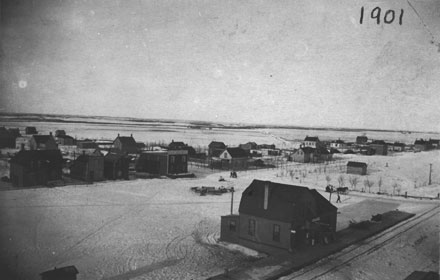 Hartney in 1901
Hartney in 1901
Influential
Hartney
Women….
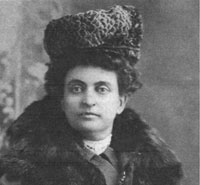 Margaret Woodhull
Margaret Woodhull
Margaret apprenticed
with
her brother and in 1901 became the first
woman graduate in pharmacy in Manitoba. She took over the pharmacy in
Hartney in 1920 – lived there until her death.
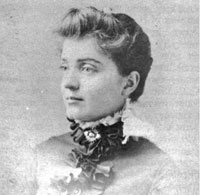 Tena Hopkins
Tena Hopkins
Miss Tena Hopkins operated the Hopkins Boarding House, 112
Spencer for nearly forty years beginning around 1901.
1902
Construction of A.E. Hill Co. Store and Lewis Building
The Lewis Building is ready to accommodate the Hartney Star
A permanent rink is built
Innes & Frank Hill take over the Flour Mill it becomes part of
Canadian Consolidated Flour Mills
William Kirkland – takes over Sackville’s brick operation
Farmer’s Elevator which grew out of ther dissatisfaction with the
costs of grain marketing, established in Hartney.
O’Briens return to operate the hotel – change the name back
to “Avondale”.
Farm wages discussed at the Farmers’ Institute - $200/year with
board and lodging is the going rate.
William Langland wins a diploma at Paris World Fair for his wheat.
Building Hartney
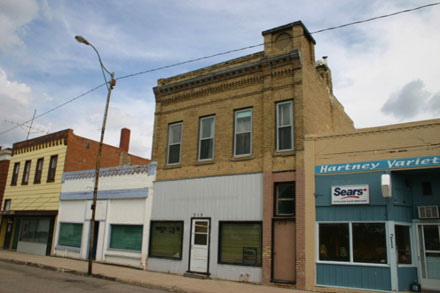
Crawford Building 2009
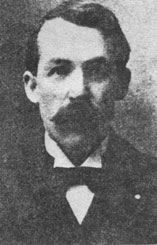
W.B. Crawford
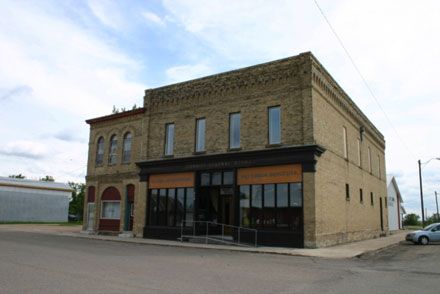
Lewis and A.E. Hill
Buildings, 2009
1903
Edward Briggs elected as Conservative M.L.A. for the Deloraine
Constituency in 1903.
Fred Alamas purchases the Hopkins Store from Mr. Hamelin and converts
it to a 30 – room hotel – with a Liquor License – but
a local vote overturned that license.
Drs. Lyall and Bigelow arrive
1904
First telephone installed in the Alma Hotel
Telephone Toll Office established in Woodhulls Pharmacy
Mr Dickson opens a furniture store
Alex Mains reorganizes his sash and door factory as joint stock co.
Syd Fyson opens a Meat & Stock Marketing operation
In May a petition for incorporation of Hartney as a town
circulates
As of 1904 there are 51 business in Hartney, plus 8 elevators
J.M. Fee assumes postmaster duties (until 1912)
1905
Hartney incorporated as a town.
The first Mayor, Dr. F. Woodhull is elected by acclamation.
CNR extended to Virden, through Grande Clairiere.
B.J. Hales becomes principal of Hartney School.
A Canoe Club is organized.
Professor Racine’s begins music lessons and leads a
variety of activities in the community
A by law is passed for 5% debentures to raise $7000 for town hall &
fire protection
September: plans for town hall submitted
Fire destroyes Finkleman & Shapiro’s Blue Store and Hall in
Novemeber
John Scott elected mayor in December.
“The Diamond”, a crossing of CN/CP tracks, is situated on
the outskirts.
A.W. “Connie” Riddell is the CPR station agent
– also popular leader in the realm of sports.
Eaton’s in Winnipeg is a major mail-order shopping service.
Isabey’s “democrat” equipped with an engine, becomes
the community’s first “car”.
1906
By- law passed to contract A. Vaughan to build town hall for $9, 895.
Work commences.
Formal agreement to purchase fire engine from Watrous Engine Works.
Telephones installed throughout town
February: “Best Ever” Prizes go to local farmers – WJ
Keeler, WA Magwood, W. Laughland , SF Long for wheat; Laughland for
Spring rye and brome grass.
Hartney School enlarged.
Walpole Mundoch builds one-storey brick printing press building.
October: The new Town Hall is opened serves as fire hall, civic
offices, meeting place and many other uses
William Avenue extended through land purchases as the town
expands.
Board walks built.
Formation of Park along CPR. Planners consult with the Brandon
Experimental Farm
Dr. Irwin arrives (stays until 1910).
The Hartney Star predicts that: “Men will not use automated
vehicles”
Grain Grower’s Grain Co. established in Hartney.
Public Buildings
1908
The first factory-built automobile purchased by W.E. Crawford. (Ford)
Others soon follow - more autos on roads
Main’s Stock dispersed and he retains only lumber sales.
Board walls replaced with concrete in main streets.
Street lamps installed.
A Local By-law requires business (except dray & harness) to close @
7:00 , except for Saturday when they are allowed to open until
midnight. (This by-law led to the YMCA).
Also a by-law for pit closets and a town scavenger.
Dr. Tolmie arrives.
1909
A.E. Crawford elected mayor.
Several stores burned.
Bandstand erected.
Oswald Shore uses car to sell farm implements.
Road signs allowed by town.
A car trip to Winnipeg is big news – Edward Briggs and J.J.
Sheppard, with Ed’s sons, Joel and Delmar, leave at 9:00 in
morning and arrive in the city at 7:00 that evening.
|
